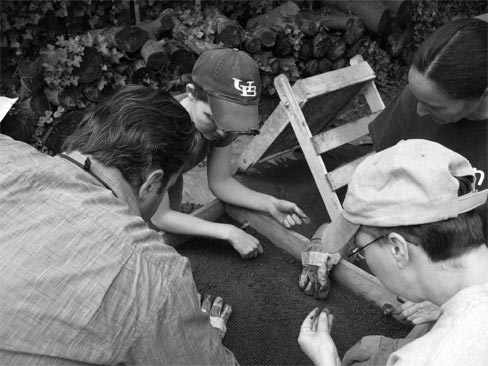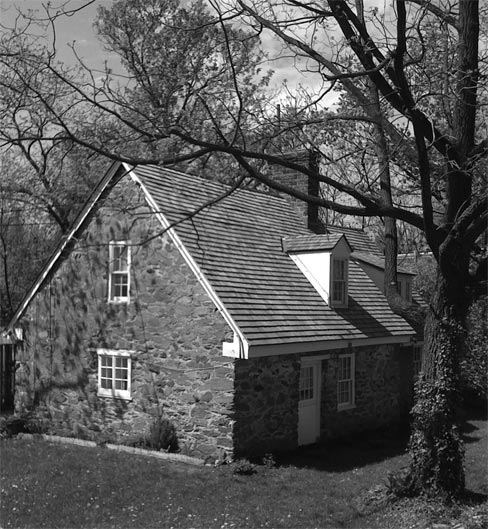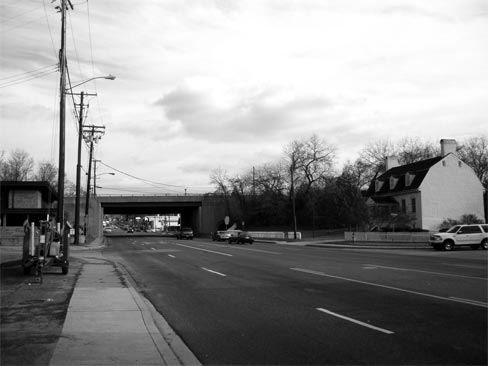Research Report
Starting Lasting Conversations about the Past: Public Outreach and the Bladensburg Archaeology Project
by Michael Roller
The Cultural Resources Section of the Maryland State Highway Administration (SHA), the Center for Heritage Resource Studies (CHRS) at the University of Maryland's Department of Anthropology, and several other community partners designed the Bladensburg Archaeology Project as a collaborative partnership to investigate the historic resources of the town of Bladensburg, Maryland in advance of the upcoming War of 1812 Bicentennial. The town, a seemingly ordinary suburban community located approximately two miles to the northeast of the Washington, DC border, has a rich and varied history that stretches back 250 years. The project includes a civic engagement component that directly involves the community in this process. Since the initiation of the project in spring 2009, archeologists and historians from the SHA and CHRS have investigated two major archeological sites, conducted documentary and deed research, and compiled architectural inventories in the town.
The richness of Bladensburg's archeological resources is often a surprise to its residents. Myriad social and demographic changes have created a diverse community with a large population of new immigrants. Older residents often express concern over the difficulty of sharing the importance of the town's historic identity with newer residents. While nearby National Park Service and Maryland-National Capital Park and Planning Commission (M-NCPPC) resources such as Anacostia Park, Kenilworth Park and Aquatic Gardens, and Anacostia Waterfront Park preserve aspects of surrounding landscape and recreational space, much of the former historic landscape in the town's core has been obliterated by industrial and commercial development. (Figure 1)
Founded as a tobacco trading port in 1742, Bladensburg predates the nation's capital by nearly 60 years. It is believed that by the third quarter of the 18th century, the port exported more tobacco than any other in Maryland.(1) The town's location near major transportation routes connecting Annapolis, Baltimore, Upper Marlboro, Alexandria, and Washington, DC also made it a convenient stopping point for travelers, including President George Washington, who recorded a visit in his diary in May 1787. As a result of its strategic location, Bladensburg served as the site of a pivotal battle during the War of 1812. The Americans, outmanned and outgunned, were ultimately defeated in the Battle of Bladensburg, resulting in the British crossing the Anacostia and burning Washington, DC on August 24, 1814.
Despite efforts at dredging, agricultural runoff irreparably filled the Anacostia with silt by the mid-19th century, preventing ships from reaching the port.(2) In subsequent years Bladensburg served as a recreational destination for city dwellers, a rural exurbia for wealthy landowners and, eventually, a suburban bedroom community for federal workers. Today, crisscrossed by transportation routes and swathed in late-20th century industrial and commercial development, the long historical origins of the town are heavily obscured to the casual observer.
The public outreach component of the project began a few weeks before excavations commenced. Using the model of the Hampden Community Archaeology Project (HCAP), an ongoing CHRS project that includes strong community involvement at all stages of research, the project began with an initial public history workshop.(3) Workshop organizers communicated the plans and goals of the project to the community, received feedback, and encouraged a collaborative and open dialogue. The workshop included a talk about local history followed by a group discussion about the project.
The Cultural Resources Section of SHA, led by Chief Archaeologist Julie Schablitsky, began excavations at the Magruder House in May 2009. The oldest standing structure in Bladensburg, the Magruder House, is a one and a half-story stone dwelling built for wealthy merchant William Hilleary around 1742.(4) Following a Ground Penetrating Radar (GPR) survey, the crew excavated shovel tests and test units. Public site tours, press tours, and news releases accompanied this work. (Figure 2) The investigation recorded artifacts and features dating to the 18th, 19th and 20th centuries, as well as Archaic and Woodland period Native American occupations. Throughout the process staff maintained a project blog with daily updates collected from each member of the field crew. Through the blog, researchers answered questions from the community and from a wider public audience.
 |
Figure 2. Project archeologists excavated the yards around the Market Master's House (c. 1760) in Bladensburg during summer 2009. (Photo courtesy of the author.) |
In June 2009, CHRS archaeologists joined the SHA crew to investigate the grounds around a c. 1760 stone structure known as the Market Master's House.(5) (Figure 3) When the town of Bladensburg was laid out into 60 original plots in 1742, the first buyers were required to erect a building to maintain ownership of the land. This diminutive dwelling meets those minimum requirements of "a tenantable House with one Brick or Stone Chimney thereto, that shall cover 400 square F[ee]t of Ground."(6) Historical research revealed that, besides a domestic and commercial function, the Market Master's House likely served as a post office.(7) If this use can be proven through archeological evidence, this building is one of the oldest standing post offices in the United States. Like the Magruder House work, open site tours, electronic documentation, and public presentation of results accompanied the excavations. Upon completion a second workshop allowed members of the community to provide feedback, view artifacts, and discuss local history.
 |
Figure 3. Project staff and local residents screen for artifacts at the Market Master's House as part of a series of public programs that included open site days, tours, and public history workshops. (Photo courtesy of Julie Schablitsky.) |
The two months following excavations involved the usual process of artifact preparation and cataloging. Blog posting and public events accompanied these activities as well. Although insufficient time had passed to produce fully analyzed scientific results from an archeological excavation, this opportunity to publicly demonstrate the process of archeology was key to project goals. Project staff attended numerous community events, celebrations, and meetings. At these events, researchers presented artifacts and archeological observations fresh from the field to the community in order to engage and invite interpretation. The hope is that in demystifying the process of doing archeology, the public will understand how it works, why it is important, and how it can be useful.
The archeological process cannot discover or create heritage; the living community must engage in a dialogue with its past. The Bladensburg Archaeology Project explored historic resources in the town with a particular emphasis on civic engagement through a variety of media and events. These methods facilitated a conversation between researchers and residents necessary for an understanding of a common heritage. In cases such as Bladensburg, where development has obscured or fragmented the historical landscape, an engaged archeology can help researchers foster interpretation, appreciation, and stewardship of local history. This knowledge aids those communities in making future choices that will protect and nurture their heritage.
About the Author
Michael Roller is a graduate student in the Department of Anthropology at the University of Maryland, College Park. The project blog can be accessed online at: http:///www.bladenarch.blogspot.com.
Notes
1. Marina King, "The Tobacco Industry in Prince George's County, 1680-1940," in Historic Contexts in Prince George's County: Short Papers on Settlement Patterns, Transportation and Cultural History (Upper Marlboro, MD: Maryland-National Capital Park and Planning Commission, 1990), 69-71.
2. Susan Pearl, "Early Towns in Prince George's County, 1683-1787," in Historic Contexts in Prince George's County: Short Papers on Settlement Patterns, Transportation and Cultural History (Upper Marlboro, MD: Maryland-National Capital Park and Planning Commission, 1990), 4.
3. David Gadsby and Robert Chidester, "History from the Bottom Up: A Research Design for Participatory Archaeology in Hampden-Woodberry, Baltimore, MD" (Center for Heritage Resource Studies, 2005). http://www.heritage.umd.edu/CHRSWeb/AssociatedProjects/Hampden.htm
4. Catherine C. Lavoie, "Magruder House, 4703 Annapolis Road (Bladensburg Road)," (HABS No. MD-616), 1990. Historic American Buildings Survey, National Park Service, U.S. Department of the Interior.
5. Marina King, "Market Master's House," National Register of Historic Places Registration Form (Upper Marlboro, MD: Prince George's County Historic Preservation Commission, 1989).
6. This research comes from the following work in progress: Laura H. Hughes et al. "Compliance Report and Historical Research for the Market Master's House, Magruder House, and the George Washington House, Bladensburg Prince George's County, Maryland" (Manuscript in progress prepared for the Maryland State Highway Administration, 2009). The evidence for this claim comes from several newspaper articles and court cases that suggest that Benjamin Lowndes, owner of the Market Master's house and postmaster of Bladensburg, may have operated the post office from this location. Future archeological excavations may prove this fact.
7. Bacon's Laws of Maryland, Archives of Maryland Online (75: 2006), 451-452.

